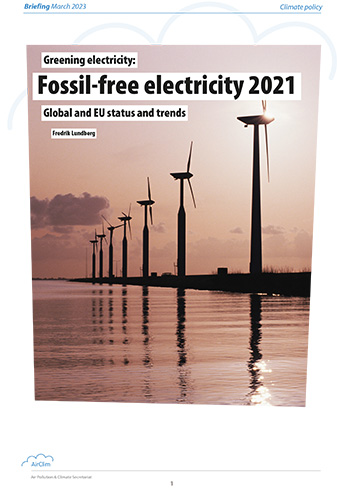
CCS could also impact air pollution
Carbon capture and storage (CCS) involves capturing carbon dioxide released by power stations and other industrial sources, and burying it deep underground. A new report from the European Environment Agency (EEA) shows that in addition to keeping an important greenhouse gas (GHG) out of the atmosphere, this technology will lead to benefits and trade-offs for air pollution.
According to the EEA study, CCS technologies require approximately 15–25 per cent more energy depending on the type of technology used, so plants with CCS need more fuel than conventional plants. This in turn can lead to increased direct emissions occurring from facilities where CCS is installed, and increased indirect emissions caused by the extraction and transport of the additional fuel.
While emissions of sulphur dioxide (SO2) from power plants are predicted to fall when CCS is used, those of particulate matter (PM) and nitrogen oxides (NOx) emissions are expected to increase in line with the amount of additional fuel consumed if no additional measures to reduce emissions are installed. Ammonia (NH3) is the only pollutant for which a significant increase in emissions is expected to occur, with emissions potentially increasing by a factor of three or more.
A case study is also presented that quantifies and highlights the range of GHG and air pollutant life-cycle emissions that could occur by 2050 should CCS be widely implemented in power plants across the European Union.
Source: EEA press release, 17 November 2011
Web link: http://www.eea.europa.eu/publications/carbon-capture-and-storage

 Download this issue
Download this issue
 Previous claims that reducing CO2 emissions would make new cars unaffordable are shown to be unfounded in a new report by Transport and Environment. Quite the opposite, cars have actually become cheaper while becoming more carbon-efficient.
Previous claims that reducing CO2 emissions would make new cars unaffordable are shown to be unfounded in a new report by Transport and Environment. Quite the opposite, cars have actually become cheaper while becoming more carbon-efficient. The social cost of carbon – or marginal damage caused by an additional ton of carbon dioxide emissions – has been estimated by a US government working group at US$21 in 2010. This is not a large number. It seems to suggest that we don't need to do much about climate change.
The social cost of carbon – or marginal damage caused by an additional ton of carbon dioxide emissions – has been estimated by a US government working group at US$21 in 2010. This is not a large number. It seems to suggest that we don't need to do much about climate change. Economic analysis of the costs of air pollution damage to the United States shows that coal-fired power generation is under-regulated and incredibly costly.
Economic analysis of the costs of air pollution damage to the United States shows that coal-fired power generation is under-regulated and incredibly costly. Macro-economic factors have been the biggest influence on changes in greenhouse gas emissions in the EU over the past two decades. To achieve the needed reduction of 80-95 per cent by 2050 impact from policy must increase.
Macro-economic factors have been the biggest influence on changes in greenhouse gas emissions in the EU over the past two decades. To achieve the needed reduction of 80-95 per cent by 2050 impact from policy must increase. Between 80 and 90 per cent of the EU urban population is exposed to levels of harmful particulate matter (PM) exceeding the air quality guideline set by the World Health Organization, and more than 95 per cent is exposed to ozone exceeding this level.
Between 80 and 90 per cent of the EU urban population is exposed to levels of harmful particulate matter (PM) exceeding the air quality guideline set by the World Health Organization, and more than 95 per cent is exposed to ozone exceeding this level. GHG emissions from transport in the EU have increased by 27 per cent since 1990. Modest efficiency gains have been outpaced by growing demand.
GHG emissions from transport in the EU have increased by 27 per cent since 1990. Modest efficiency gains have been outpaced by growing demand. In recent years the West Antarctic Ice Sheet has started to show signs of instability: ice shelves the size of European countries have broken off from coastal areas and glaciers have begun to accelerate into the ocean.
In recent years the West Antarctic Ice Sheet has started to show signs of instability: ice shelves the size of European countries have broken off from coastal areas and glaciers have begun to accelerate into the ocean. An insecure, inefficient and high-carbon energy system, is what we can expect if there is no radical change in the direction of policy, warned the International Energy Agency (IEA) when it launched the annual World Energy Outlook in November.
An insecure, inefficient and high-carbon energy system, is what we can expect if there is no radical change in the direction of policy, warned the International Energy Agency (IEA) when it launched the annual World Energy Outlook in November. Questions and answers about the Kyoto Protocol by Climate Action Network Europe
Questions and answers about the Kyoto Protocol by Climate Action Network Europe The references documents for best available technique (BAT) for large combustion plants are under review. New issues like oil shale, firing of high-sulphur coal and greenhouse gases such as nitrous oxide and sulphur hexafluoride will be considered.
The references documents for best available technique (BAT) for large combustion plants are under review. New issues like oil shale, firing of high-sulphur coal and greenhouse gases such as nitrous oxide and sulphur hexafluoride will be considered.











